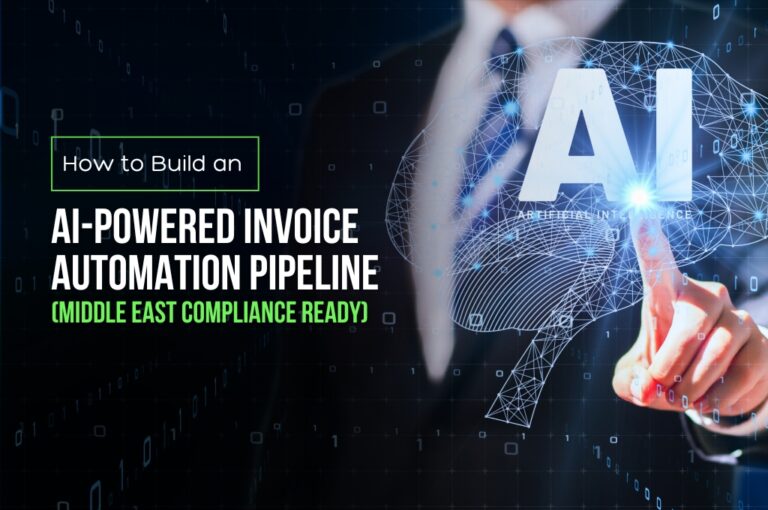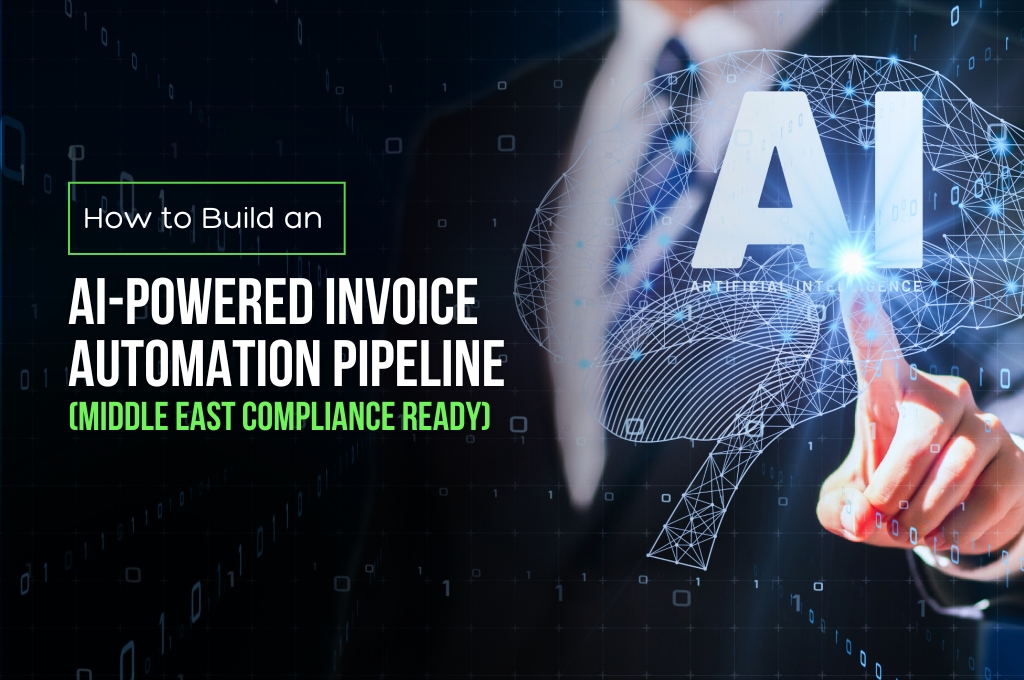If your finance team is still buried under spreadsheets, manual invoice checks, and late approvals – you’re not alone. But here’s the kicker: in the Middle East, invoice processing isn’t just about speed or accuracy. It’s about compliance.
With countries like Saudi Arabia enforcing ZATCA e-invoicing mandates, and others like the UAE adopting stringent VAT requirements, traditional automation alone isn’t enough. You need intelligence. You need adaptability. You need a system that’s AI-powered and region-ready.
In this blog, we’ll walk you through the exact steps to build a smart automated invoice processing pipeline using machine learning as a service, designed to meet both global efficiency standards and Middle Eastern compliance laws.
Let’s get started.
Step 1: Understand Regional Compliance Requirements
Before you plug in any automation tool, you need to understand what compliance actually looks like in the Middle East. Because here, it’s not just about processing an invoice – it’s about doing it in a way that aligns with government-regulated formats, tax mandates, and real-time auditability.
Key compliance considerations:
Saudi Arabia – ZATCA & FATOORAH
The Zakat, Tax and Customs Authority (ZATCA) mandates e-invoicing in two phases. All invoices must follow XML-based formats, include VAT IDs, and be submitted electronically in real-time.
United Arab Emirates – VAT Regulations
Invoices must reflect accurate VAT breakdowns, supplier registration numbers, and meet electronic recordkeeping standards for audits.
Qatar, Bahrain, Oman
These markets are catching up fast – with VAT implementations and upcoming digital tax frameworks that will affect how invoices are submitted and stored.
Any automated invoice processing pipeline must be built around these rules. Your AI models and data flows should validate region-specific fields like VAT number, registration codes, Arabic/English formatting, and ensure digital archiving for at least 5 years (as mandated in some regions).
Step 2: Choose the Right Document Ingestion & OCR Tools
At the heart of any invoice automation pipeline lies the ability to read and extract data from diverse invoice formats – and in the Middle East, that often means handling Arabic text, bilingual documents, and complex tax fields.
Here’s how to get it right:
What you need:
OCR Tools with Arabic Support
Choose optical character recognition (OCR) engines that support both English and Arabic – this is critical for digitizing VAT-compliant invoices across the UAE, Saudi Arabia, and Egypt.
Support for Multiple File Types
Your pipeline should be able to ingest PDFs, XML, scanned images, and even handwritten forms in some legacy processes.
Cloud-Native or MLaaS-Ready Integrations
Consider tools like Google Document AI, Amazon Textract, or Azure Form Recognizer, which can be enhanced via machine learning as a service for better data accuracy and self-improvement over time.
By selecting the right ingestion and OCR layer, you’re ensuring that your pipeline starts with clean, structured, and compliant data – instead of a digital mess.
Step 3: Train AI to Extract, Validate & Categorize Invoices
Once your OCR layer is pulling data from invoices, the next step is where the real intelligence kicks in – training AI models to understand, verify, and sort invoice data like a seasoned finance analyst.
How it works:
Data Extraction with Context
AI models go beyond surface-level OCR. They learn to map “Invoice Number,” “VAT ID,” “Supplier Name,” etc., even when layouts change across vendors or regions.
Smart Validation Rules
Your pipeline should verify mandatory Middle Eastern compliance fields – like checking for valid VAT registration numbers, ZATCA formats, or proper currency and tax mapping.
Categorization & Line Item Structuring
AI can auto-classify expenses, split line items by category (freight, services, goods), and tag them to the right cost centers – saving hours of manual effort.
Why MLaaS matters:
Using machine learning as a service platforms allows you to build pipelines that constantly improve. Over time, your models get better at handling edge cases, identifying fraud patterns, and adapting to new invoice formats.
This step ensures your pipeline doesn’t just process data – it understands it.
Step 4: Build Automated Approval Workflows
With clean, validated data in place, it’s time to move the invoice through your organization – without email chains or paper trails.
Here’s how to automate it:
Set Logic-Based Routing Rules
Route invoices based on predefined logic: department, invoice amount, vendor type, or urgency. For instance, invoices over AED 50,000 could go to finance heads; recurring utility bills can be auto-approved.
Middle East-Specific Controls
Include approval checkpoints for ZATCA-compliant fields, VAT thresholds, or Arabic tax notations before processing. These checks avoid compliance risks during audits.
Exception Handling
Flag incomplete or non-matching invoices (e.g., missing PO, tax mismatch) for human review. AI can assign priority levels and auto-learn common exceptions using machine learning as a service.
Notification & Audit Trail
Every action – from routing to rejection – should be logged, timestamped, and retrievable to meet audit standards in countries like Saudi Arabia and the UAE.
This step turns your invoice pipeline into a real-time, compliance-ready workflow – no more bottlenecks, no more surprises.
Step 5: Integrate with Accounting / ERP Systems
Your pipeline is only as powerful as its ability to sync with the tools that actually move money – your ERP or accounting platform.
Seamless integration means:
Auto-Posting to ERP
Once an invoice is approved, the data should flow directly into platforms like SAP, Oracle, QuickBooks, or Zoho Books – no manual entry required.
Middle East Compatibility
For Saudi Arabia, ensure integration supports ZATCA Phase 2 (e.g., e-invoice generation, QR code attachment). In the UAE, link with VAT-compliant invoice templates and audit trails.
Two-Way Sync
Let your ERP validate vendor details, check purchase orders, and update payment statuses back into the pipeline – creating a full feedback loop.
Audit Trail & Archiving
All integrated data must be timestamped, version-controlled, and archived for at least 5 years, as per regulatory mandates in the region.
By this stage, your pipeline not only processes invoices – it completes the financial loop.
Step 6: Monitor, Optimize, and Stay Audit-Ready
Automation isn’t a “set it and forget it” process – especially when regulations evolve and vendors change formats. The final piece of your pipeline ensures long-term resilience and compliance.
What to include:
Real-Time Dashboards
Track key metrics like invoice approval time, flagged exceptions, tax validation failures, and vendor-specific issues – in a single view.
Automated Compliance Updates
In regions like Saudi Arabia, laws shift quickly. Using machine learning as a service, your pipeline can adapt to updated ZATCA or VAT formats without full rework.
Anomaly Detection
Train models to spot suspicious patterns: duplicate invoices, odd payment cycles, or mismatched line items – improving fraud prevention over time.
Regulatory Archive Access
Make audit-readiness a feature, not a scramble. Every invoice should be retrievable by invoice ID, date, or vendor – in the exact format required by regional tax authorities.
This step future-proofs your pipeline – and keeps your finance team out of regulatory trouble.
Build smarter. Stay compliant. Automate invoices with AI built for the Middle East – secure, scalable, and always audit-ready.




